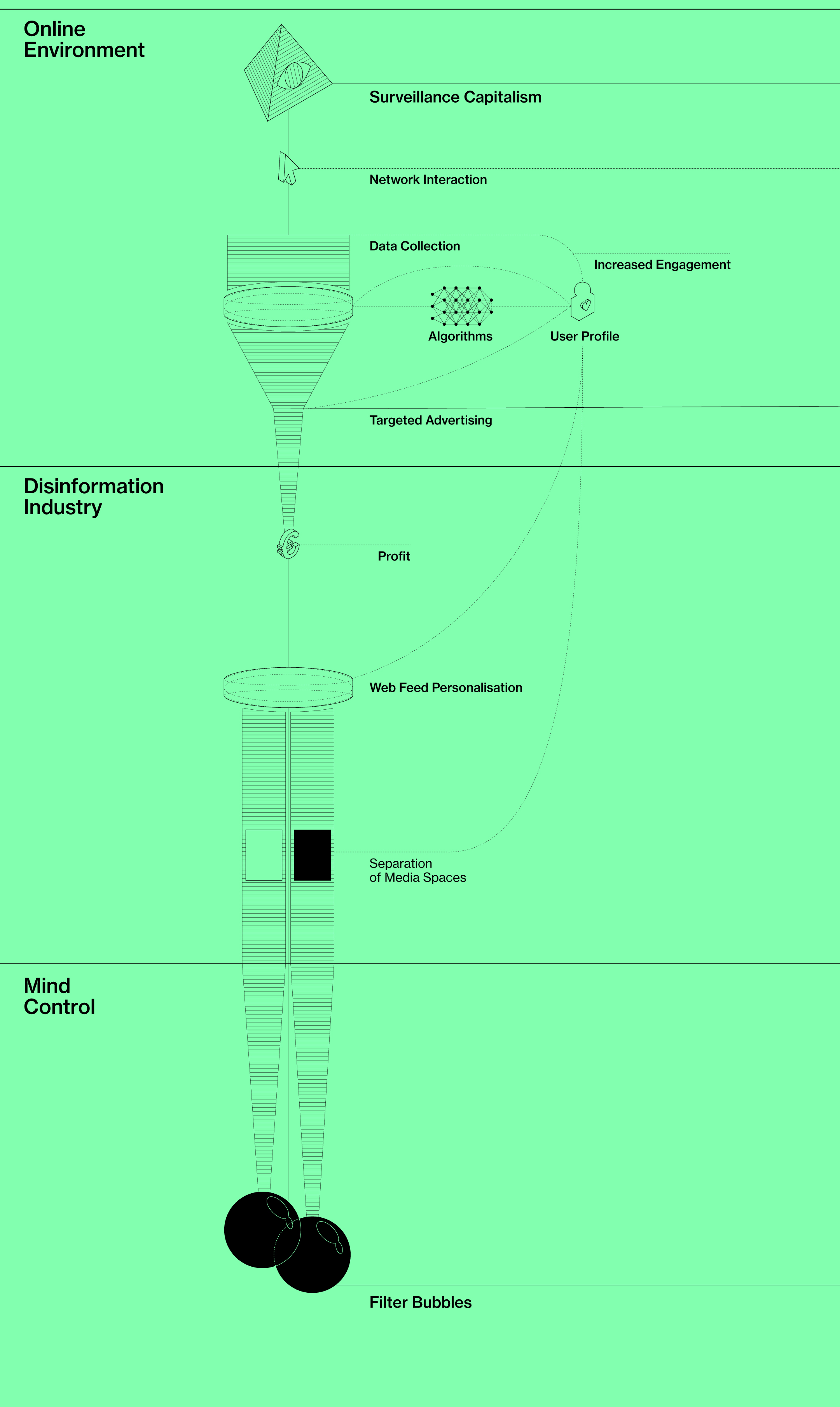



|
"Disinformation Machine Diagram" is an excerpt of a piece for "The Daily Post-Truth" newspaper by students of the master's degree in Communication Design at FBAUL (Abel Quental and Diogo Lourenço), based on Paulo Pena’s lecture "Truth or Lies: Democracy and Populism”, presented in the context of The Daily Post-Truth, a joint project between the Department of Communication Design of the Faculty of Fine Arts of the University of Lisbon (FBAUL) and maat. |
|
DISINFORMATION MACHINE DIAGRAM
The Daily Post-Truth
Paulo Pena defines disinformation as a process of intentional manipulation of public opinion by the exercise of media and information control. But what are the power structures behind this process? Who’s in charge? Who are the agents? What are the tactics?
The image of the factory appears frequently in recent research and journalistic work navigating the world of disinformation; Russian troll factories are one of the most notorious examples. But this is no mere analogy. The recent success of disinformation campaigns – e.g. the election of the former US president – clearly shows how profitable and effective the production of fake news and disinformation is as a real industry.
Drawing on this idea of industrial production, Disinformation Machine Diagram aims to show the flows and connections of the disinformation industry in the form of a blueprint, map or diagram.
The diagram is built from an interpretation of the research on disinformation by Paulo Pena and Investigate Europe, including the following references:
-
Pruszkiewicz Cieśla, Paulo Pena (2019) Inside a troll factory.
-
Manuel Vilarinho Pires (2018), A incrível e triste história de Catarina Martins e do seu Patek Philippe desalmado.
-
Paulo Pena (2019), Fábrica de Mentiras: Viagem ao Mundo das Fake News.
-
Paulo Pena (2019), Nove passos para distinguir informação de fake news.
The bar chart component of the diagram is based on FABLAB’s report on disinformation in Portugal:
-
Gustavo Cardoso, Inês Narciso, José Moreno, Nuno Palma (2019), Social Media disinformation in the pre-electoral period in Portugal
Disinformation Machine Diagram on maat ext. is an excerpt of a piece for The Daily Post-Truth newspaper by students of the master's degree in Communication Design at FBAUL (Abel Quental and Diogo Lourenço), based on Paulo Pena’s lecture "Truth or Lies: Democracy and Populism”, presented in the context of a joint project between the Department of Communication Design of the Faculty of Fine Arts of the University of Lisbon (FBAUL) and maat.
|
The Daily Post-Truth is a joint project between the Communication Design Department of the Faculty of Fine Arts, University of Lisbon (FBAUL) and the Museum of Art, Architecture and Technology (maat), developed in the scope of maat mode 2020 programme. The project is motivated by a renewed interest in fiction, within artistic practices and design in particular, as one of the discursive modes that is best able to restore a sense of reality in an age governed by post-truth. Within this context, the newspaper, as one of the media that most evidently suffered the effects of disinformation, becomes prone to appropriation and recuperation.
|
By creatively exploring this publishing model in crisis, The Daily Post-Truth proposes the development of a newspaper, while focusing on the tensions between truth and post-truth, fiction and reality. “The Daily Post-Truth” uses fiction as the basis for a speculative and critical design practice that seeks to question the tenets of the dissemination of disinformation in the post-truth era. The newspaper was developed in a four-day workshop at maat in January 2021, coordinated by António Nicolas, Luísa Ribas and Sofia Gonçalves, with students of the master’s degree in Communication Design (FBAUL): Abel Quental, Beatriz Pinta, Diogo Lourenço and Madalena Lopes.
|








